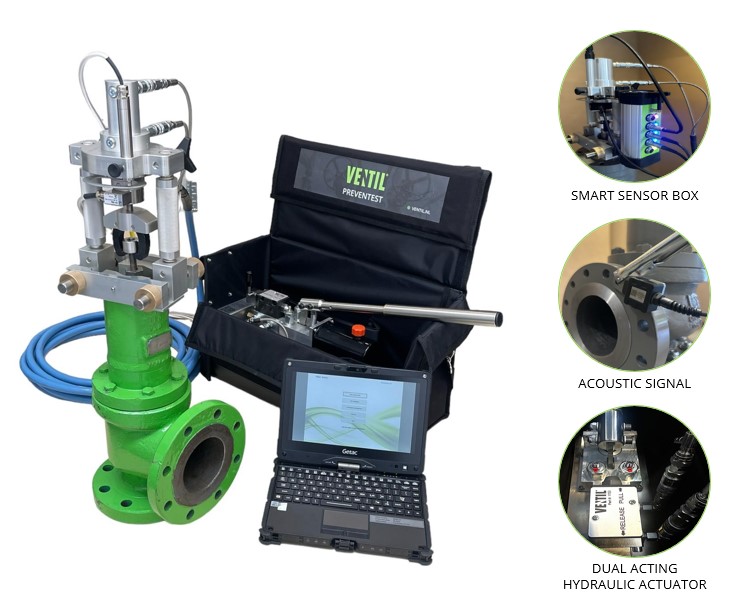PREVENTEST NEXUS
“Testing with an ALAD is universal, our approach makes the difference!”
VENTIL’s PREVENTEST NEXUS is an Auxiliary Lift Assist Device (ALAD), specifically designed to perform in-situ testing of all types and sizes of spring-operated Pressure Relief Valves (PRVs) under normal operating conditions.
In line with ASME’s Performance Test Code (PTC) 25, this method offers a reliable alternative to conventional testing by enabling functional testing of PRVs without removal—provided it is carried out correctly and with the appropriate equipment.
THE POWER OF NEXUS
– At its core lies a powerful software and database—preloaded with over 4,000 seat sizes from the world’s leading Pressure Relief- and Safety Valve manufacturers.
– Enables full test replay, synchronized force–lift–acoustic analysis, and unmatched opening pressure accuracy.
– Tamper-proof results by locking line pressure before testing.
– Automated pass/fail evaluations based on international standards.
– A smart sensor box links to your laptop—wirelessly or wired—powering precise load and acoustic sensors to capture every valve detail.
In the high-stakes world of PRV testing—where accuracy, integrity, and compliance are non-negotiable—one system sets the benchmark: VENTIL’s PREVENTEST NEXUS.
DESIGNED WITH THE OPERATOR IN MIND
– Lightweight, reducing fatigue and the risk of repetitive strain injuries.
– Easy to operate, with an intuitive interface that requires minimal training.
– Multilingual, making it accessible to teams around the world.
– Off-grid capable, requiring no electrical cables—perfect for remote or hazardous environments.
– Benefit from flexible one-day training—either at your workshop, on-site, or remotely if in-person isn’t possible—so you can quickly master the PREVENTEST NEXUS with minimal downtime.
– ATEX application pending, expanding its future use in explosive atmospheres.
With over 700 units installed, alongside calibration services and operator training, this proven approach has been an effective solution for more than 25 years.
BASIC PRINCIPLE OF IN-SITU TESTING
The universal test rig is placed on top of the Pressure Relief Valve, and is connected to the valve spindle. A gradually increasing pulling force is applied to the spindle to overcome the spring tension of the valve. This is achieved by using a hydraulic power pack linked to an electronic force transducer. A computer with smart software is then used to measure the force applied. By combining the data with the information about the valve seat and line pressure it is possible to accurately assess the set pressure.
ADVANTAGES!
– Only valves that require overhaul and service need to be removed from the plant
– Welded-in valves can be adjusted without costly removal from the line
– No need for temperature corrections
– Reduced time needed to commission plant after shutdown
– No interruption to plant production during testing; no loss of productivity and no loss of profitability
CONTACT FORM


